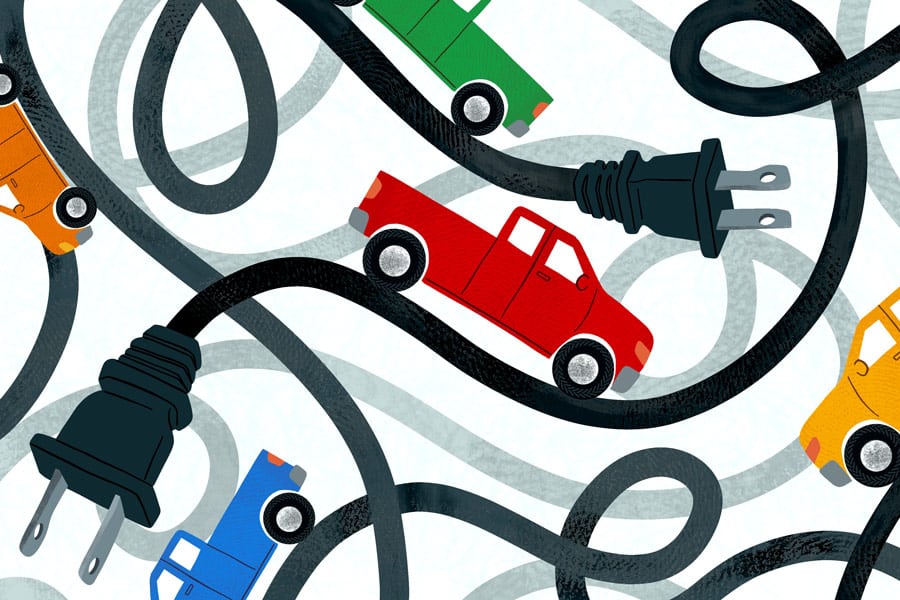Illustration by Lindsay Gruetzmacher
They’re big, tough and loud—and it’s hard to say which of these characteristics is most popular with construction workers.
The large, open beds make trucks ideal for carrying equipment, parts, tools and toolboxes, and to access them quickly. If it won’t all fit, pickups also have the power to tow multi-ton weights, and their large tires can handle the muddiest construction sites without getting mired.
With the increase in four-door options, pickup trucks can be family vehicles, too. Late models are downright luxurious, with heated and cooled seats, dual-zone climate control, sunroofs and electric power available almost everywhere on most models.
But until now, it’s been missing in one key location—under the hood.
Despite the burgeoning number of electric vehicles (EVs) on the market in the past decade, none of them were pickup trucks, and it’s not easy shoehorning a 2” x 8” into a Nissan Leaf. Although EVs represent 1% of the 250 million vehicles in the United States, only 2,000 of those vehicles were electric trucks at the end of 2019.
Big vehicles like trucks and SUVs remain the most popular auto segment among buyers, despite their low fuel efficiency and high emissions. But electric brands—from industry trailblazer Tesla to stalwarts GM, Ford and Chevrolet, to upstarts like Rivian and Bollinger—are on a roll, with EV trucks starting to appear in fall 2021 and many more coming in the years ahead.
Advantages of electric vehicles
The price of an electric truck initially stuns most shoppers, but over the long haul, proponents say the benefits outstrip the costs. “Electric pickup trucks are much more efficient at construction sites due to higher torque and generally faster operation,” said Sean Chapman, professional carpenter and founder of the Tools’n’Goods tool and machinery review blog. “An electric pickup truck is much cheaper and simpler to maintain than any truck with internal combustion due to the lower price of electricity and simplicity of EV motors.”
Here’s a closer look at the primary advantages:
Higher fuel efficiency: The Environmental Protection Agency fueleconomy.gov website provides useful information on energy consumption for all makes and models of vehicles, from diesel to hybrid to electric. Even the most fuel-efficient pickup trucks on the road today get a combined EPA fuel economy of 27 miles per gallon (mpg) or less, although some of the hybrids boast up to 37 mpg. A pickup owner who drives 1,250 miles per month in a vehicle that gets 25 mpg needs 50 gallons of diesel at about $3.50 a gallon at current prices for a total of $175. Driving 15,000 miles in this scenario would cost about $2,100.
Compare that with the cost of an EV. The average US rate for residential electricity was 13.99 cents per kWh in August 2021, according to the Energy Information Administration. Traveling 100 miles in a Rivian R1T truck takes about 48 kWh of electricity, according to the EPA. That means the monthly cost to drive 1,250 miles runs about $84. The EPA estimates $950 in annual electricity costs, assuming 15,000 miles.
Massive torque: Electric trucks naturally provide higher torque than their diesel counterparts, letting them generate more twisting force when they’re hauling, towing or climbing.
Less maintenance: With no moving parts, electric pickups require far less maintenance than traditional vehicles, saving money and time. The battery, motor and electronics are mostly hands-off. The only fluids to replace are coolant, brake and windshield washer fluid. Regenerative braking also reduces brake wear.
No emissions: Running on electricity makes EVs healthier for people and the environment, thanks to less air pollution. Even if the electricity to charge a pickup comes from a coal-fired power plant, the carbon footprint will still be smaller.
Accessories: Some new models support plug-ins for power tools and other equipment. For example, in an outage, the Ford F-150 can offload 9.6 kW to power lights, appliances and other home systems. On construction sites that don’t yet have power, the built-in electrical outlets available with enhanced Pro Power Onboard lets tradespeople run tools, electronics and appliances.
Coming this way
“Construction workers should take towing capacity and range into account when choosing electric pickup trucks,” Chapman said. Most can easily work eight hours and then recharge overnight on a 240-volt charger. Here’s a quick look at specs for models on the market now and those coming in the next few years.
- 314-mile and more than 400-mile range depending on the model
- Power delivered independently to each wheel
- 835 hp, 908 lb-ft torque
- Payload: 1,760 pounds
- Towing: 11,000 pounds
- More than 350-mile range
- Off-road performance that includes the option to crab walk around obstacles
- Up to 1,000-hp with tri-motor, 7,400 lb-ft torque
- Payload: Not released as of November 10, 2021
- Towing: Not released as of November 10, 2021
- 250-mile range with single motor, 300-mile range with dual, 500-mile range with tri
- 1,020 hp, 1,050 lb-ft torque
- Payload: 3,500 pounds
- Towing: 7,500 pounds, 10,000 pounds, or 14,000 pounds depending on motor
- 200-mile range
- Combined 614 hp with two inboard motors, 668 lb-ft torque
- Payload: 5,001 pounds
- Towing: 7,500 pounds
- 230-mile range, 300-mile extended range
- 426 hp or 563 hp, 775 lb-foot torque standard
- Payload: 2,000 pounds
- Towing: 10,000 pounds
- 500-mile range
- 159- to 200-kWh battery packs
- Horsepower, torque, payload, towing: Not released as of November 2021
- 350-mile range
- Single-motor rear-drive and dual-motor AWD
- Horsepower, torque, payload, towing: Not released as of November 2021
Inevitable change
In the decades to come, the availability of fuel-powered vehicles will decline. In California, for example, Gov. Gavin Newsom has mandated that all new vehicles sold in the state be emission-free by 2035. That edict means more EVs everywhere as businesses adopt EVs—including electric construction vehicles and the 100,000 Rivian electric vans that e-commerce retailer Amazon has ordered to deliver its goods.
Chapman, for his part, currently drives a 2009 Ford F-150 but is considering purchasing the commercial version of the 2022 Ford F-150 Lightning. “It’s one of the most affordable vehicles in the category and will be produced by the brand I trust the most,” he said. “I’m sure it will provide me with the same level of convenience but won’t consume as much money for gas and maintenance.”
As the price comes down and the technical specs rev up, it’s worth keeping a close eye on the benefits vs. the costs to decide if it’s time to trade a diesel workhorse for its electric successor.












